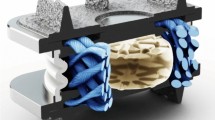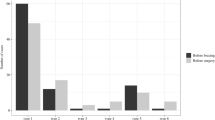Abstract
A prospective radiographic study of the influence of total disc replacement on spinal sagittal balance. The goal of this study was to prospectively determine the effect of a single-level, total disc replacement on the sagittal balance of the spine, especially on sacral tilt (ST), pelvic tilt (PT), and lumbar lordosis. It has been shown that lumbar fusion may deleteriously alter the sagittal balance of the spine, including a decrease in the ST and lumbar lordosis. Clinically, postfusion pain has been shown to be significantly related to a decreased ST, increased PT, and decreased lumbar lordosis, independent of other factors such as pseudoarthrosis. To our knowledge, the influence of total disc replacement on spinal sagittal balance has not yet been reported in the literature. This is a prospective study of 35 patients who received a single level disc replacement using the Maverick Total Disc Arthroplasty system (Medtronic Sofamor Danek, Memphis, Tennessee) by a single surgeon at one institution from March 2002 to September 2003. The preoperative and postoperative radiographic evaluation included standing anteroposterior and lateral full spine films that included the femoral heads. The parameters studied were ST, PT, global and segmental lordosis, and global kyphosis. The average age of the 35 patients studied was 44.3 years (range 35–57). There were 18 females and 17 males. The disc arthroplasty was performed at the L4–L5 level in 19 patients and at the L5–S1 level in 16 patients. The average follow-up was 14 months (range 6–22 months). The preoperative values of global lordosis, ST, and PT were 51.5°, 37.8°, 16.9° and, at last follow-up, they were 51.4°, 37.4°, and 17.5°, respectively. These changes were not significantly different. When the groups were separated according to the level operated, there was still no statistical difference with regard to the overall lordosis, ST, PT or kyphosis from pre- to postoperative period or when the two groups were compared with each other. The level above the prosthesis has always significantly less lordosis. In the present study with use of a motion-preserving Maverick prosthesis, it appears that the patient is able to maintain the preoperative sagittal balance. The prosthesis has enough freedom of motion to allow the patient to maintain the natural sagittal and spinopelvic balance needed to prevent potential undue stress on the muscles and the sacroiliac joint. Although the number of patients is small, this is the first study to our knowledge that evaluates the sagittal balance after motion-preserving total disc arthroplasty.


Similar content being viewed by others
References
Bertagnoli R, Kumar S (2002) Indications for full prosthetic disc arthroplasty: a correlation of clinical outcome against a variety of indications. Eur Spine J 11(Suppl 2):S131–S136
Duval-Beaupere G, Schmidt C, Cosson P (1992) A Barycentremetric study of the sagittal shape of spine and pelvis: the conditions required for an economic standing position. Ann Biomed Eng 20(4):451–462
Espeland A et al (1998) Observer variation in plain radiography of the lumbosacral spine. Br J Radiol 71(844):366–375
Gelb DE et al (1995) An analysis of sagittal spinal alignment in 100 asymptomatic middle and older aged volunteers. Spine 20(12):1351–1358
Godde S et al (2003) Influence of cage geometry on sagittal alignment in instrumented posterior lumbar interbody fusion. Spine 28(15):1693–1699
Goldstein JA et al (2001) Lumbar sagittal alignment after fusion with a threaded interbody cage. Spine 26(10):1137–1142
Griffith SL et al (1994) A multicenter retrospective study of the clinical results of the LINK SB Charite intervertebral prosthesis. The initial European experience. Spine 19(16):1842–1849
Hammerberg EM, KB Wood (2003) Sagittal profile of the elderly. J Spinal Disord Tech 16(1):44–50
Huang RC et al (2003) Long-term flexion-extension range of motion of the prodisc total disc replacement. J Spinal Disord Tech 16(5):435–440
Korovessis P, Stamatakis M, Baikousis A (1999) Segmental roentgenographic analysis of vertebral inclination on sagittal plane in asymptomatic versus chronic low back pain patients. J Spinal Disord 12(2):131–137
Lazennec JY et al (2000) Sagittal alignment in lumbosacral fusion: relations between radiological parameters and pain. Eur Spine J 9(1):47–55
Le Huec JC et al (2003) Maverick Total Lumbar Disc Replacement: A prospective study and preliminary report of 30 cases at 1 year follow-up. In: Annual meeting of the spine society of Europe. Prague
Legaye J et al (1998) Pelvic incidence: a fundamental pelvic parameter for three-dimensional regulation of spinal sagittal curves. Eur Spine J 7(2):99–103
Lemaire JP et al (1997) Intervertebral disc prosthesis. Results and prospects for the year 2000. Clin Orthop 337:64–76
Ng JK et al (2001) Range of motion and lordosis of the lumbar spine: reliability of measurement and normative values. Spine 26(1):53–60
Polly DW Jr et al (1996) Measurement of lumbar lordosis. Evaluation of intraobserver, interobserver, and technique variability. Spine (discussion 1535–1536) 21(13):1530–1535
Shea KG et al (1998) A comparison of manual versus computer-assisted radiographic measurement. Intraobserver measurement variability for Cobb angles. Spine 23(5):551–555
Stephens GC, Yoo JU, Wilbur G (1996) Comparison of lumbar sagittal alignment produced by different operative positions. Spine (discussion 1807) 21(15):802–806
Tribus CB, Belanger TA, Zdeblick TA (1999) The effect of operative position and short-segment fusion on maintenance of sagittal alignment of the lumbar spine. Spine 24(1):58–61
Troyanovich SJ et al (1995) Intra- and interexaminer reliability of the chiropractic biophysics lateral lumbar radiographic mensuration procedure. J Manipulative Physiol Ther 18(8):519–524
Vaz G et al (2002) Sagittal morphology and equilibrium of pelvis and spine. Eur Spine J (discussion 88) 11(1):80–87
Vedantam R et al (1998) Comparison of standing sagittal spinal alignment in asymptomatic adolescents and adults. Spine 23(2):211–215
Author information
Authors and Affiliations
Corresponding author
Rights and permissions
About this article
Cite this article
Le Huec, J., Basso, Y., Mathews, H. et al. The effect of single-level, total disc arthroplasty on sagittal balance parameters: a prospective study. Eur Spine J 14, 480–486 (2005). https://doi.org/10.1007/s00586-004-0843-9
Received:
Accepted:
Published:
Issue Date:
DOI: https://doi.org/10.1007/s00586-004-0843-9




